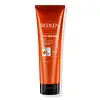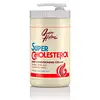What's inside
What's inside
 Key Ingredients
Key Ingredients

No key ingredients
 Benefits
Benefits

 Concerns
Concerns

 Ingredients Side-by-side
Ingredients Side-by-side

Water
Skin ConditioningCetearyl Alcohol
EmollientParaffinum Liquidum
EmollientOrbignya Oleifera Seed Oil
EmollientAmodimethicone
Dipalmitoylethyl Hydroxyethylmonium Methosulfate
Cetyl Esters
EmollientCetrimonium Chloride
AntimicrobialParfum
MaskingCaprylyl Glycol
EmollientSodium Benzoate
MaskingCitric Acid
BufferingTrideceth-6
EmulsifyingBenzyl Salicylate
PerfumingDilauryl Thiodipropionate
AntioxidantBenzyl Alcohol
PerfumingLinalool
PerfumingHexyl Cinnamal
PerfumingGeraniol
PerfumingAmyl Cinnamal
PerfumingCoumarin
PerfumingCitronellol
PerfumingWater, Cetearyl Alcohol, Paraffinum Liquidum, Orbignya Oleifera Seed Oil, Amodimethicone, Dipalmitoylethyl Hydroxyethylmonium Methosulfate, Cetyl Esters, Cetrimonium Chloride, Parfum, Caprylyl Glycol, Sodium Benzoate, Citric Acid, Trideceth-6, Benzyl Salicylate, Dilauryl Thiodipropionate, Benzyl Alcohol, Linalool, Hexyl Cinnamal, Geraniol, Amyl Cinnamal, Coumarin, Citronellol
Water
Skin ConditioningGlyceryl Stearate
EmollientParaffinum Liquidum
EmollientStearyl Alcohol
EmollientLanolin
EmollientMyristamidopropyl Dimethylamine Phosphate
CleansingGlycerin
HumectantPropylene Glycol
HumectantAloe Barbadensis Leaf Juice
Skin ConditioningCeteth-24
CleansingCetrimonium Chloride
AntimicrobialCholeth-24
EmulsifyingDisodium EDTA
Keratin Amino Acids
Skin ConditioningMethylparaben
PreservativePhenoxyethanol
PreservativeBenzyl Salicylate
PerfumingParfum
MaskingCI 17200
Cosmetic ColorantCI 16035
Cosmetic ColorantCI 47005
Cosmetic ColorantWater, Glyceryl Stearate, Paraffinum Liquidum, Stearyl Alcohol, Lanolin, Myristamidopropyl Dimethylamine Phosphate, Glycerin, Propylene Glycol, Aloe Barbadensis Leaf Juice, Ceteth-24, Cetrimonium Chloride, Choleth-24, Disodium EDTA, Keratin Amino Acids, Methylparaben, Phenoxyethanol, Benzyl Salicylate, Parfum, CI 17200, CI 16035, CI 47005
Ingredients Explained
These ingredients are found in both products.
Ingredients higher up in an ingredient list are typically present in a larger amount.
Benzyl Salicylate is a solvent and fragrance additive. It is an ester of benzyl alcohol and salicylic acid. This ingredient can be naturally found in some plants and plant extracts.
In fragrances, Benzyl Salicylate may be a solvent or a fragrance component. In synthetic musk scents, it is used as a solvent. For floral fragrances such as lilac and jasmine, it is used as a fragrance component. The natural scent of Benzyl Salicylate is described as "lightly-sweet, slightly balsamic".
While Benzyl Salicylate has been associated with contact dermatitis and allergies, emerging studies show it may not be caused by this ingredient alone.
However, this ingredient is often used with fragrances and other components that may cause allergies. It is still listed as a known allergen in the EU. We recommend speaking with a professional if you have concerns.
Another study from 2021 shows Benzyl Salicylate may have anti-inflammatory properties.
Learn more about Benzyl SalicylateThis ingredient is a preservative, antimicrobial, and emulsifier. It is often used in cosmetics for its ability to cleanse, condition, and reduce static.
Cetrimonium chloride is a quaternary ammonium salt, meaning it has a water-soluble structure.
Paraffinum Liquidum is also known as liquid paraffin. It is a type of highly refined mineral oil.
Like other oils, Paraffinum Liquidum has emollient properties. Emollients help soothe and soften the skin. By creating a barrier to trap moisture within, emollients help keep your skin hydrated.
Paraffinum Liquidum does not irritate the skin and is non-comedogenic.
Learn more about Paraffinum LiquidumParfum is a catch-all term for an ingredient or more that is used to give a scent to products.
Also called "fragrance", this ingredient can be a blend of hundreds of chemicals or plant oils. This means every product with "fragrance" or "parfum" in the ingredients list is a different mixture.
For instance, Habanolide is a proprietary trade name for a specific aroma chemical. When used as a fragrance ingredient in cosmetics, most aroma chemicals fall under the broad labeling category of “FRAGRANCE” or “PARFUM” according to EU and US regulations.
The term 'parfum' or 'fragrance' is not regulated in many countries. In many cases, it is up to the brand to define this term.
For instance, many brands choose to label themselves as "fragrance-free" because they are not using synthetic fragrances. However, their products may still contain ingredients such as essential oils that are considered a fragrance by INCI standards.
One example is Calendula flower extract. Calendula is an essential oil that still imparts a scent or 'fragrance'.
Depending on the blend, the ingredients in the mixture can cause allergies and sensitivities on the skin. Some ingredients that are known EU allergens include linalool and citronellol.
Parfum can also be used to mask or cover an unpleasant scent.
The bottom line is: not all fragrances/parfum/ingredients are created equally. If you are worried about fragrances, we recommend taking a closer look at an ingredient. And of course, we always recommend speaking with a professional.
Learn more about ParfumWater. It's the most common cosmetic ingredient of all. You'll usually see it at the top of ingredient lists, meaning that it makes up the largest part of the product.
So why is it so popular? Water most often acts as a solvent - this means that it helps dissolve other ingredients into the formulation.
You'll also recognize water as that liquid we all need to stay alive. If you see this, drink a glass of water. Stay hydrated!
Learn more about Water